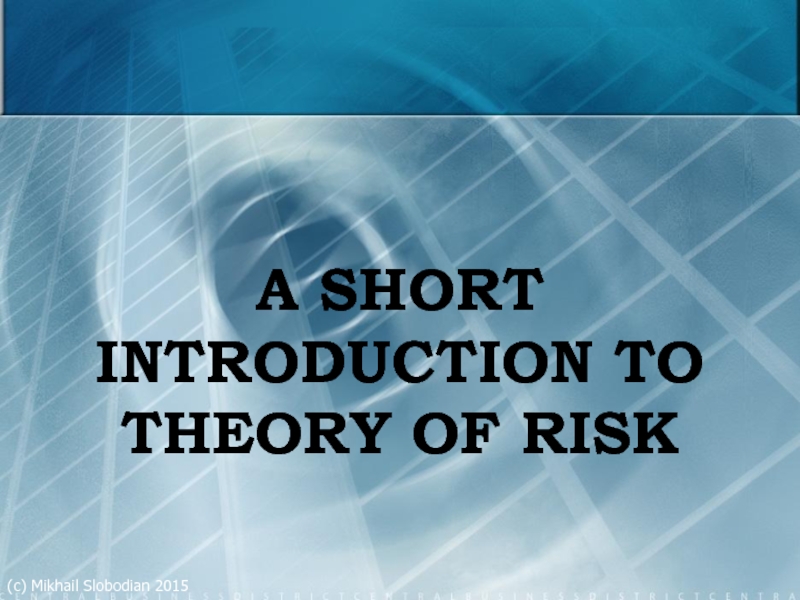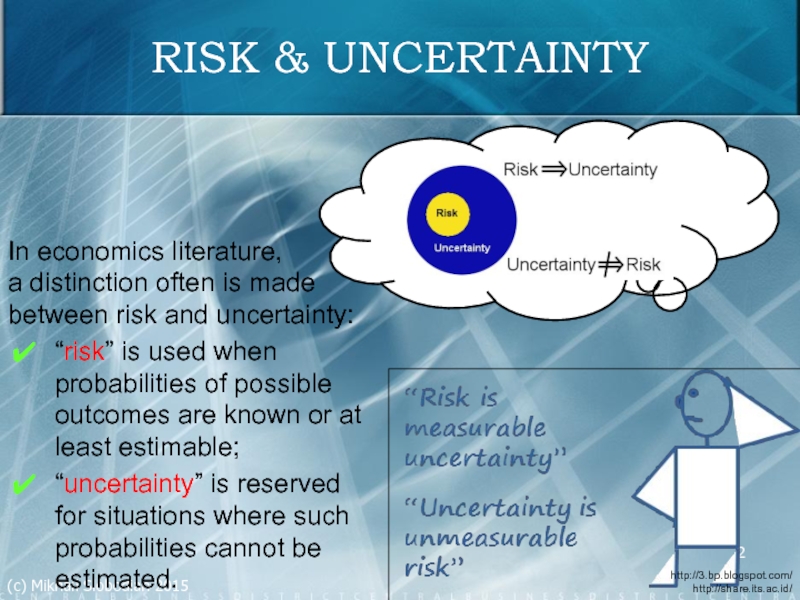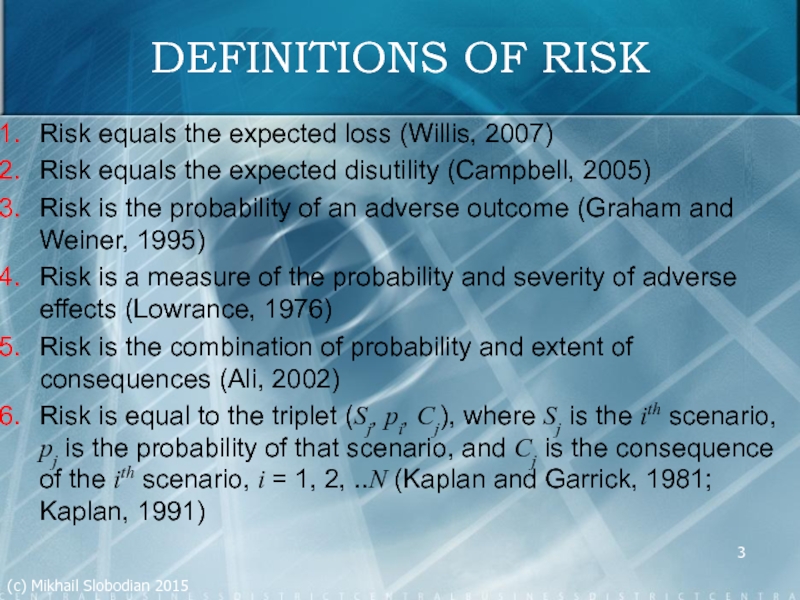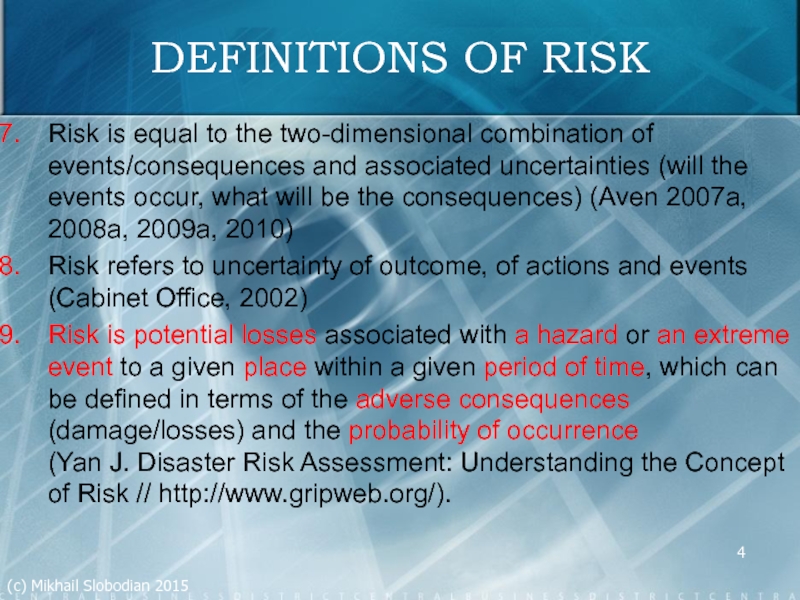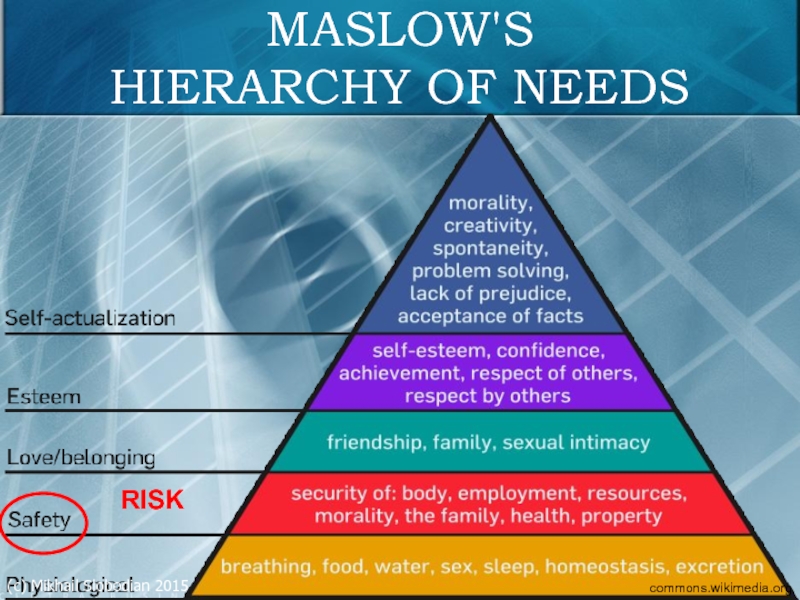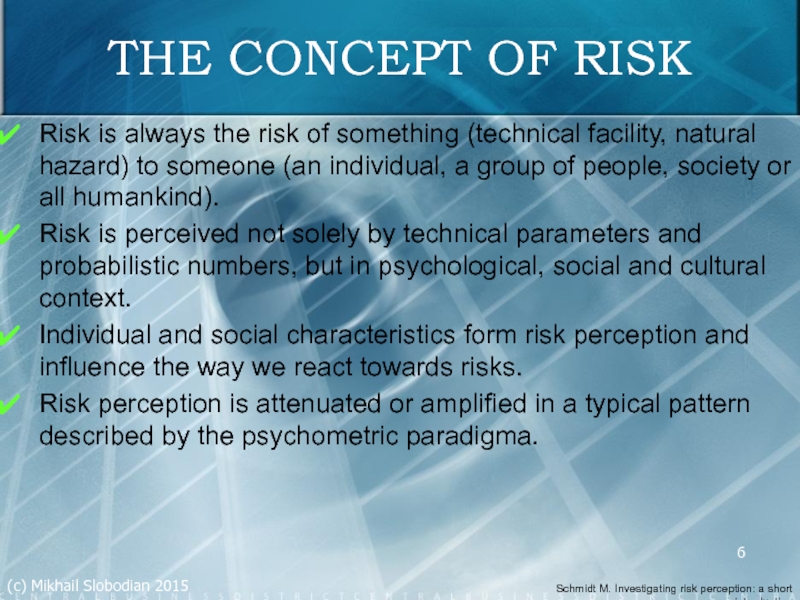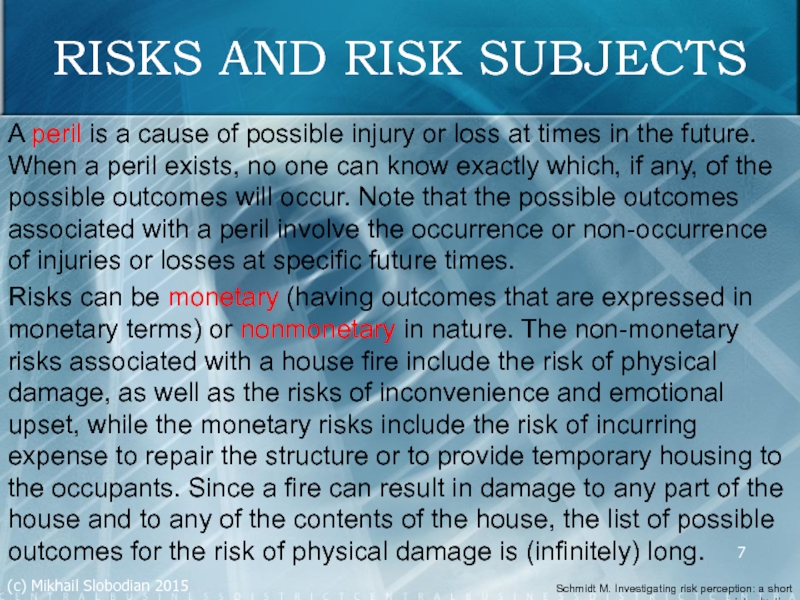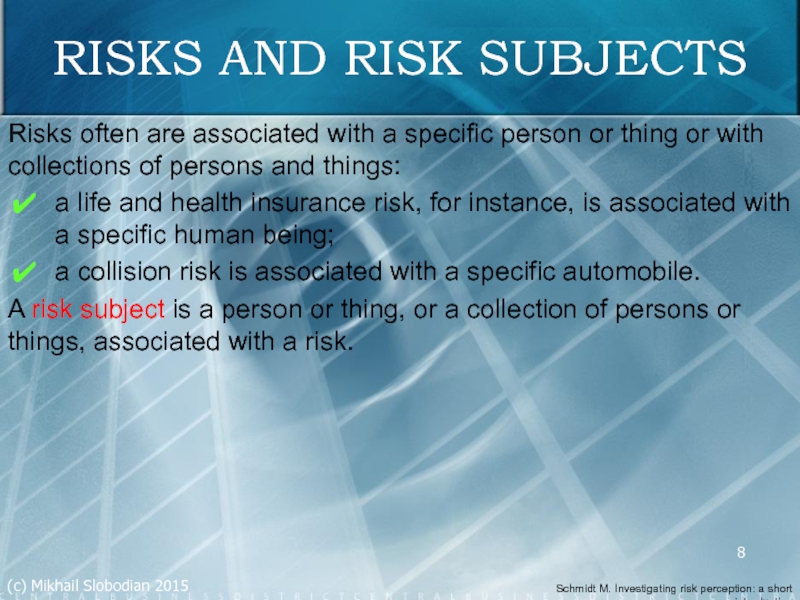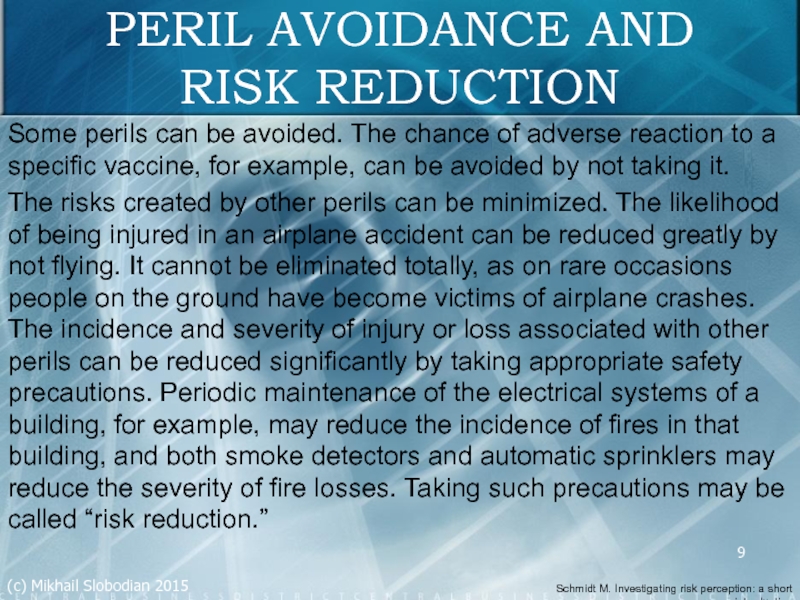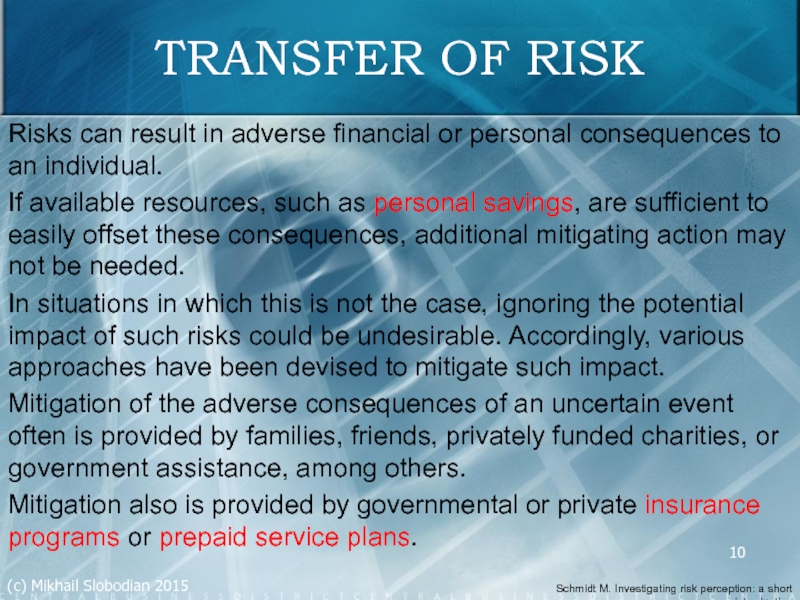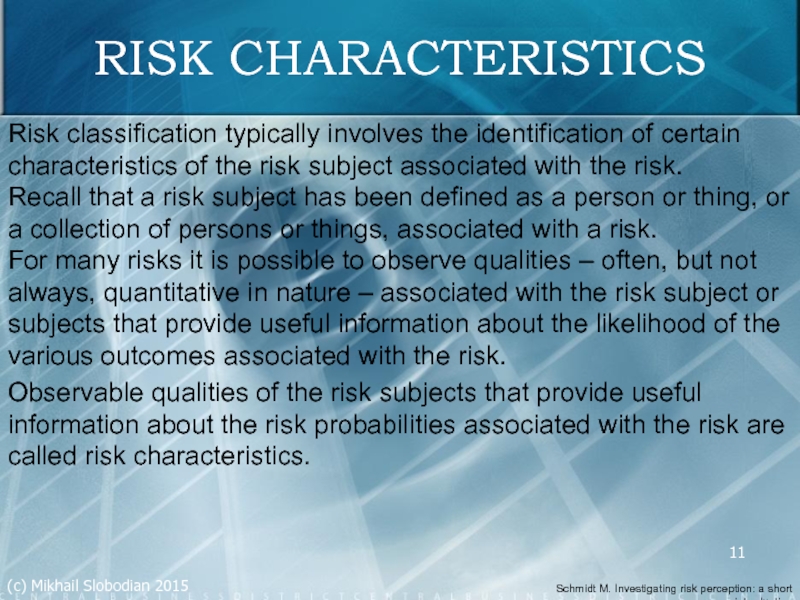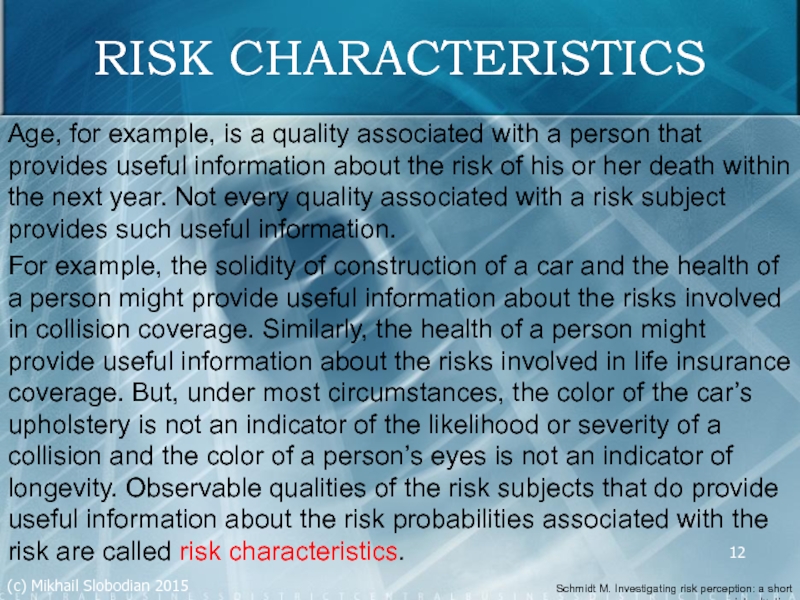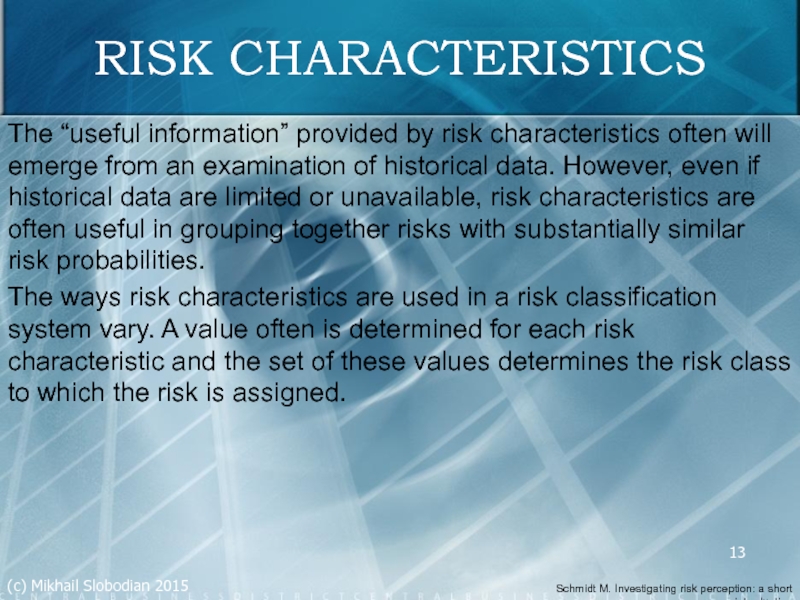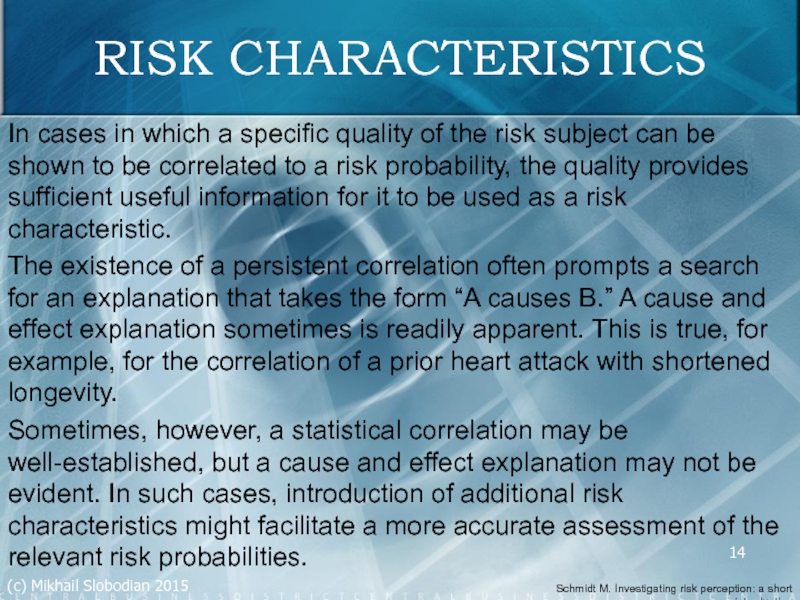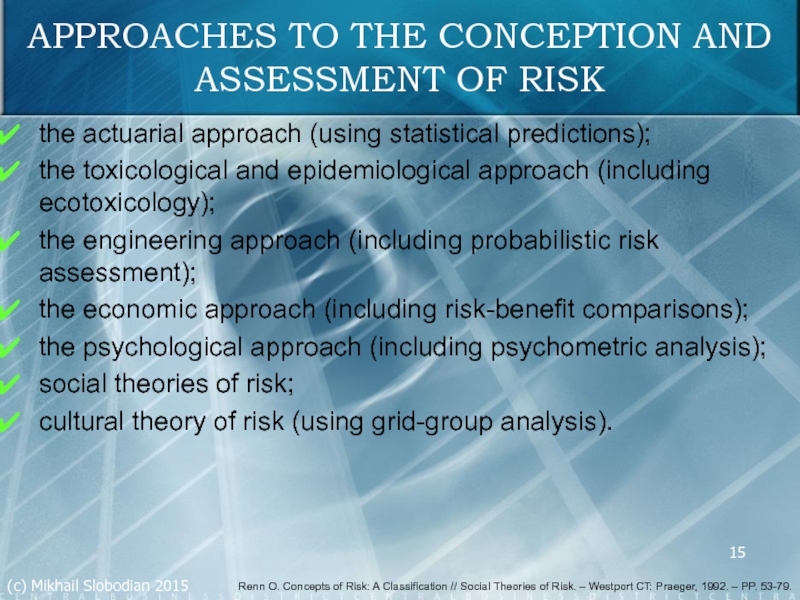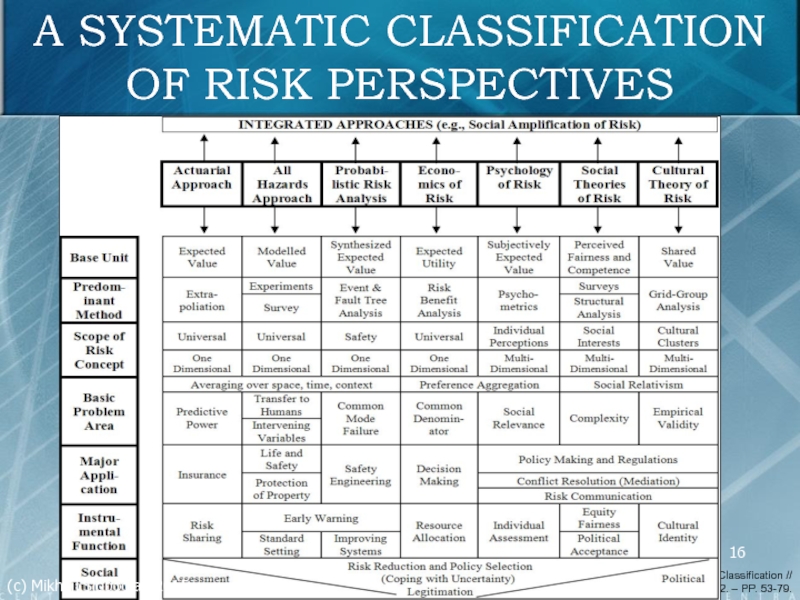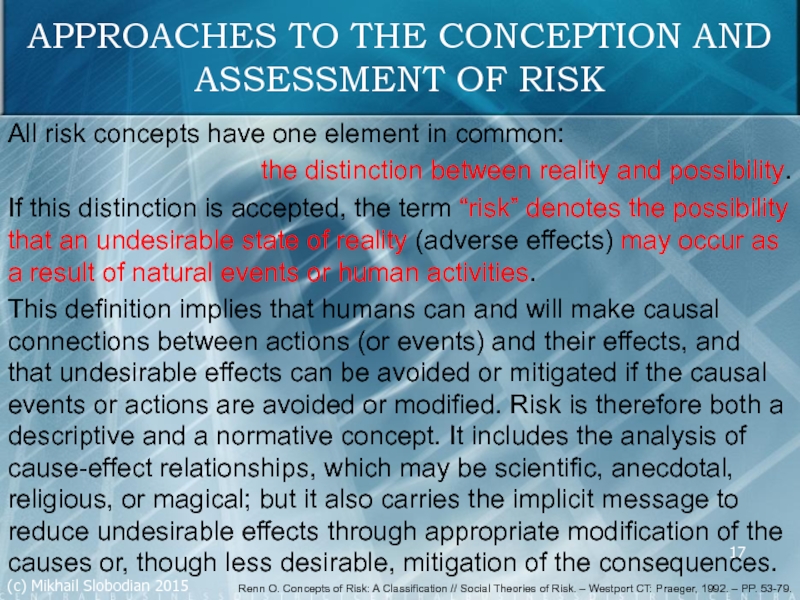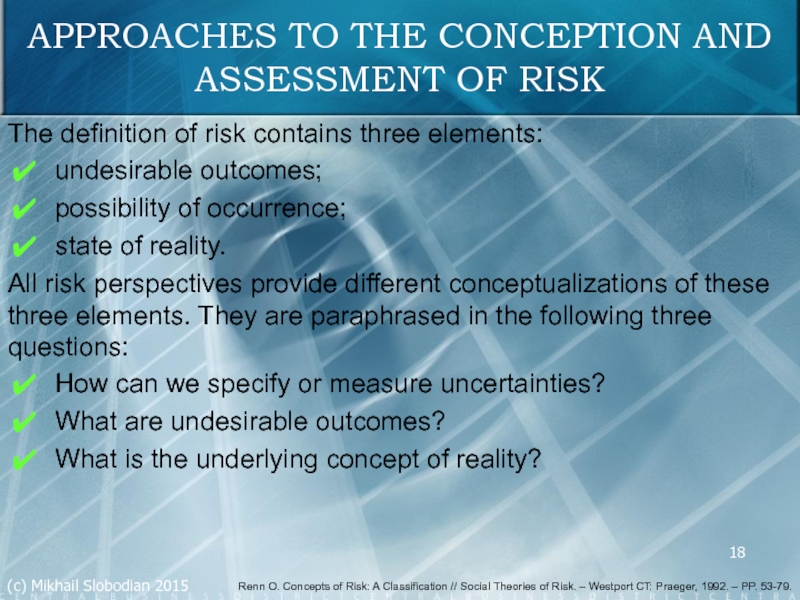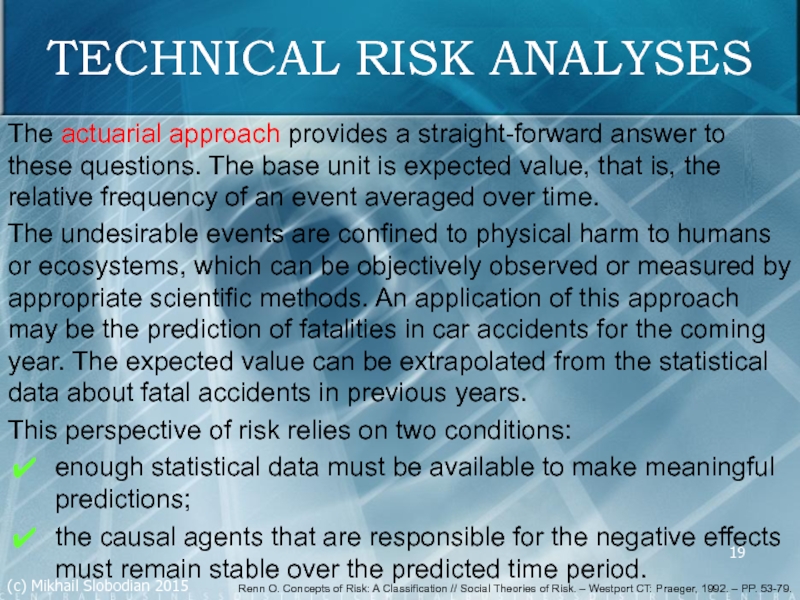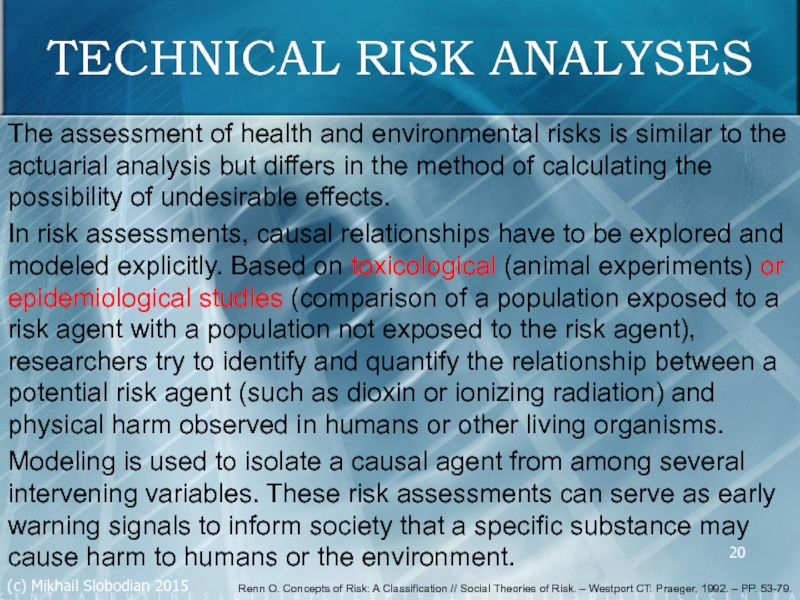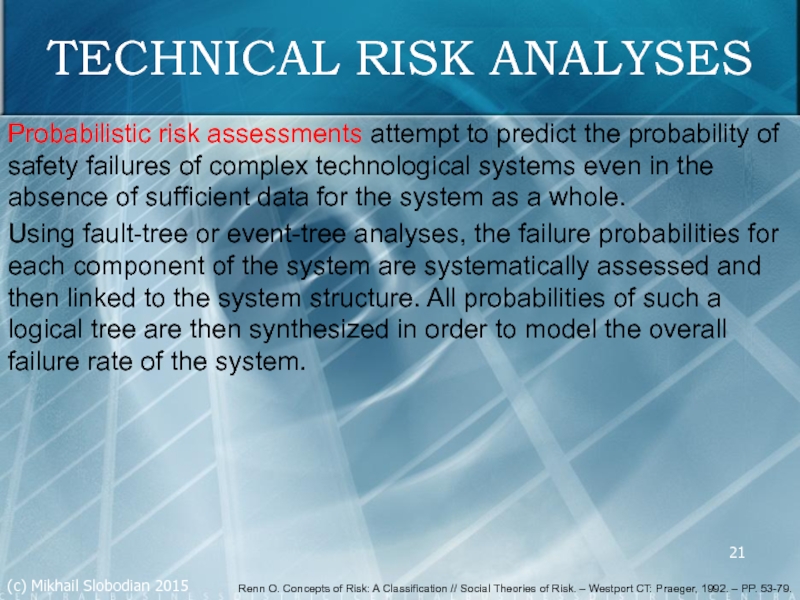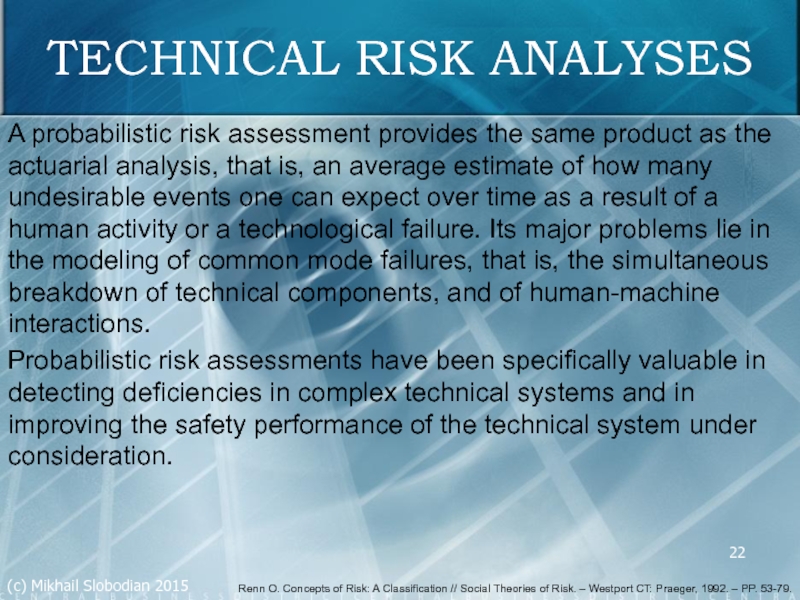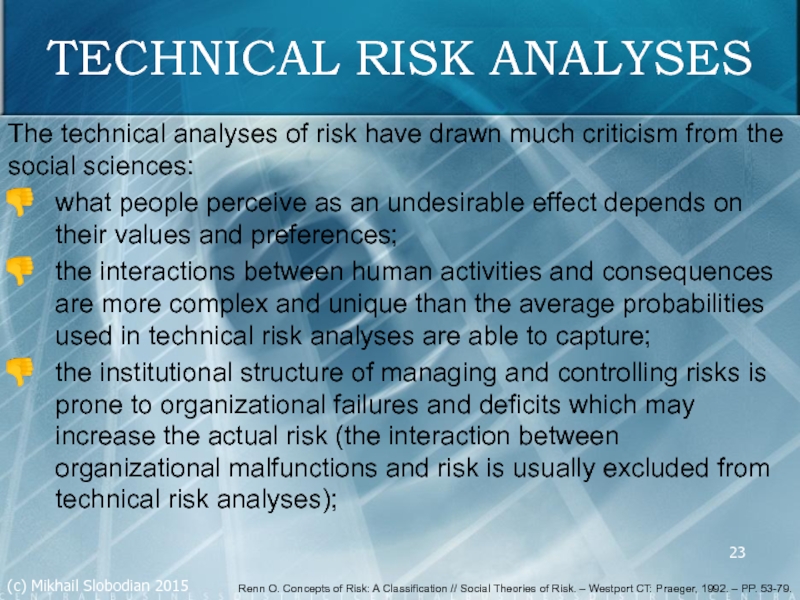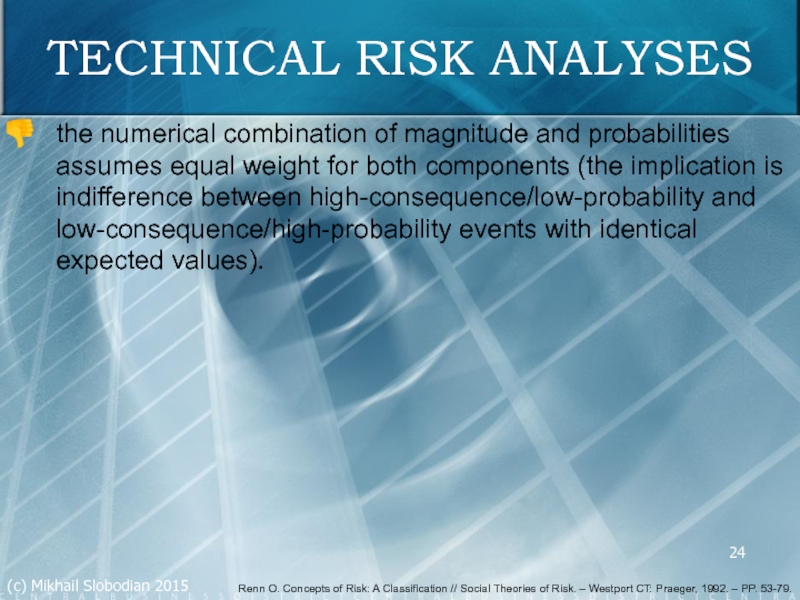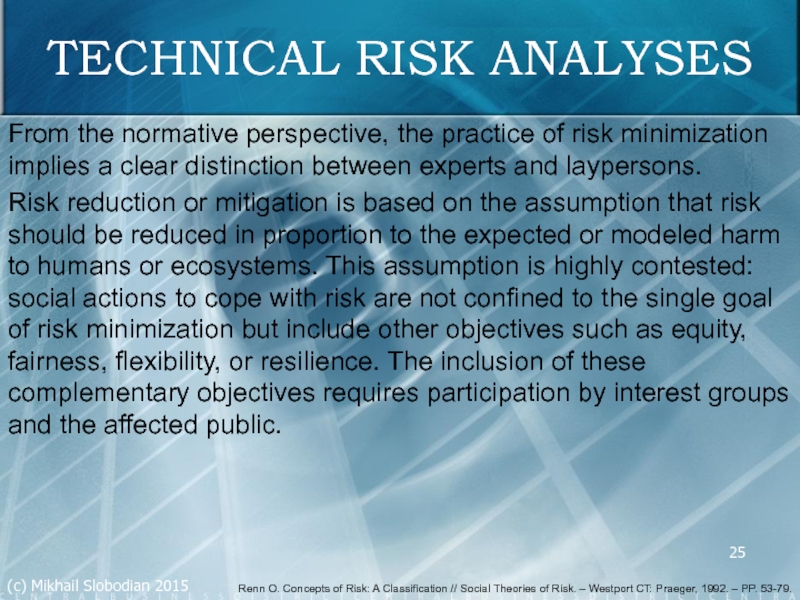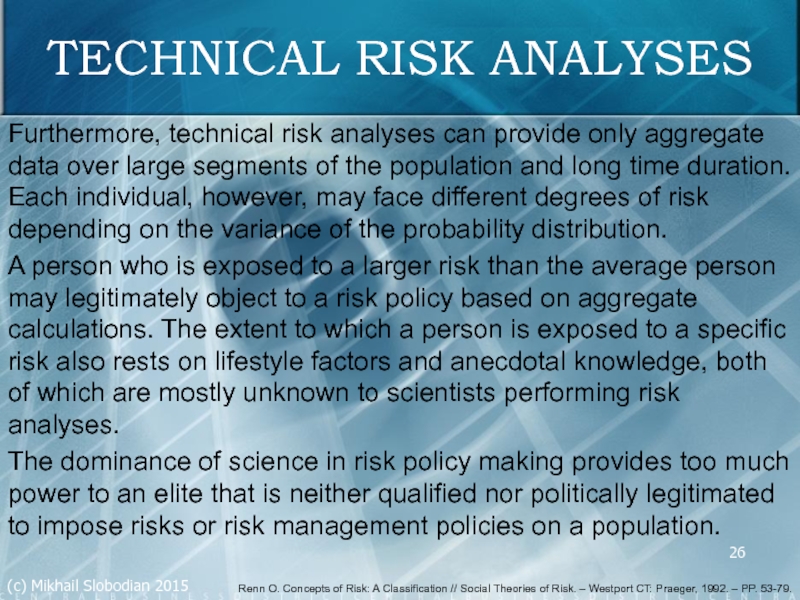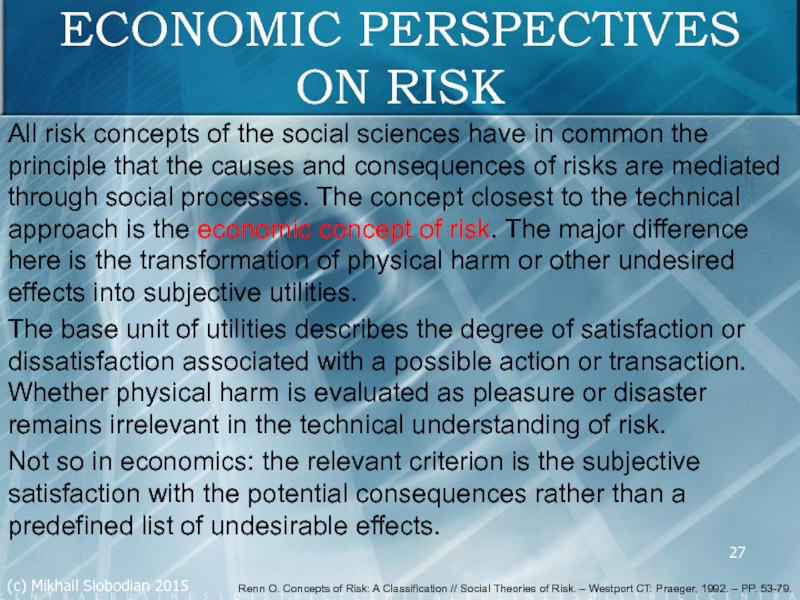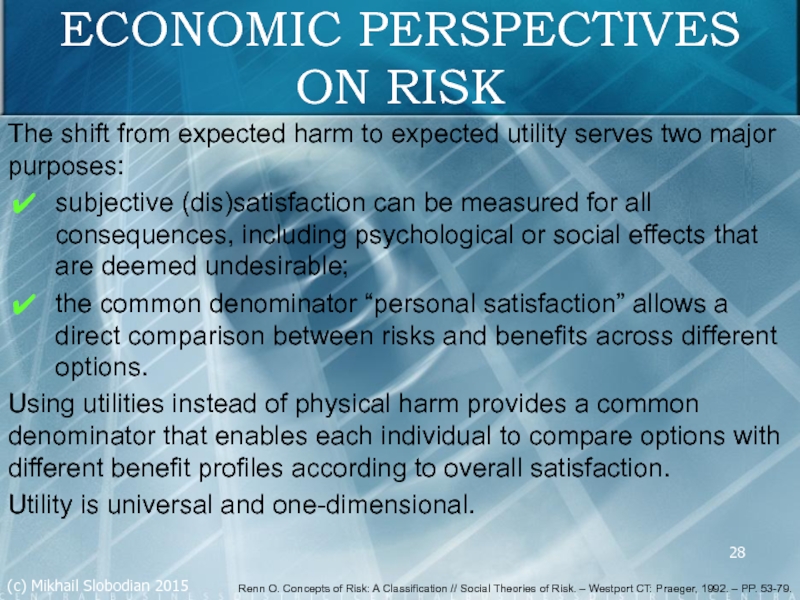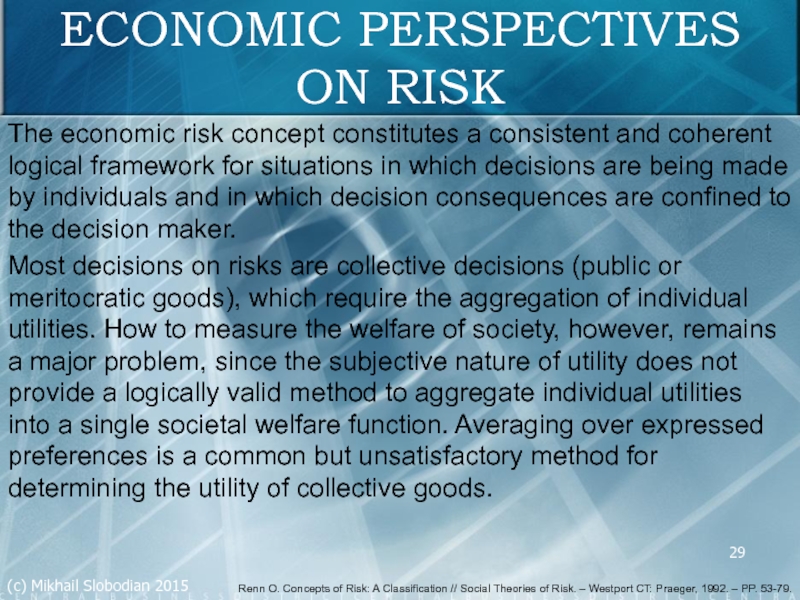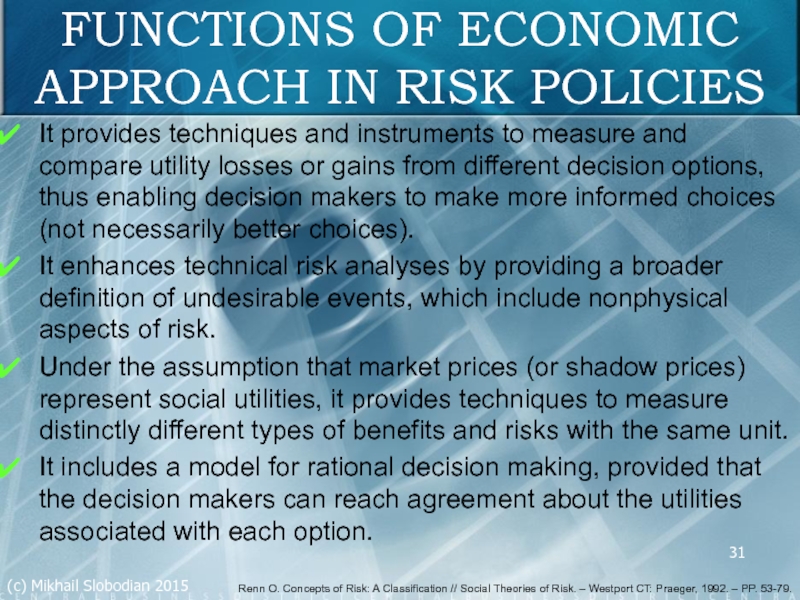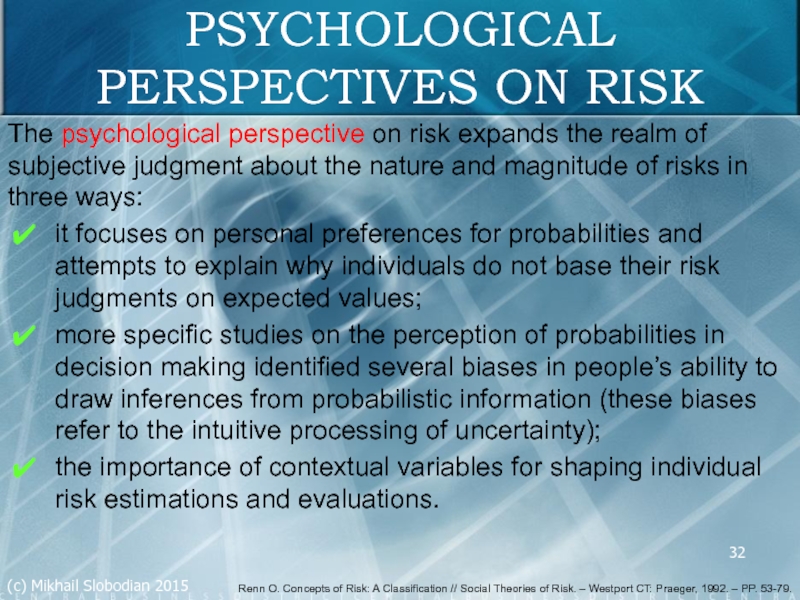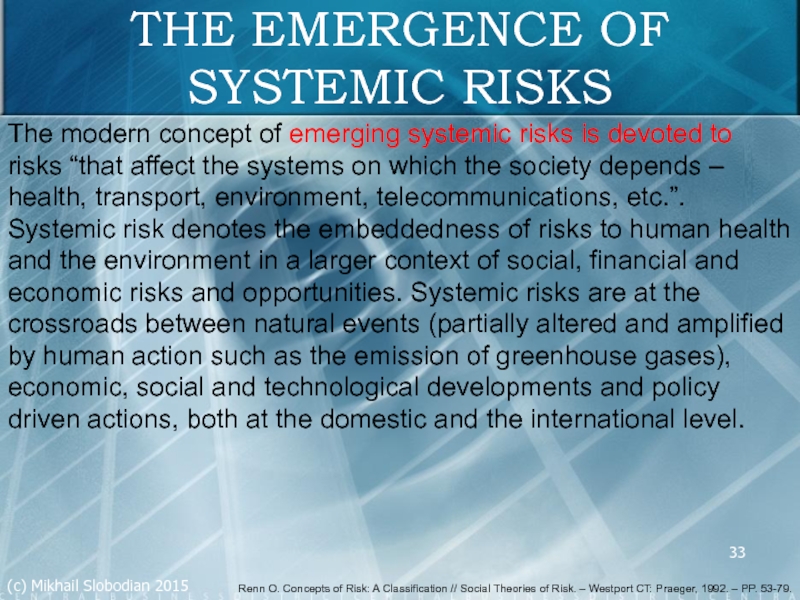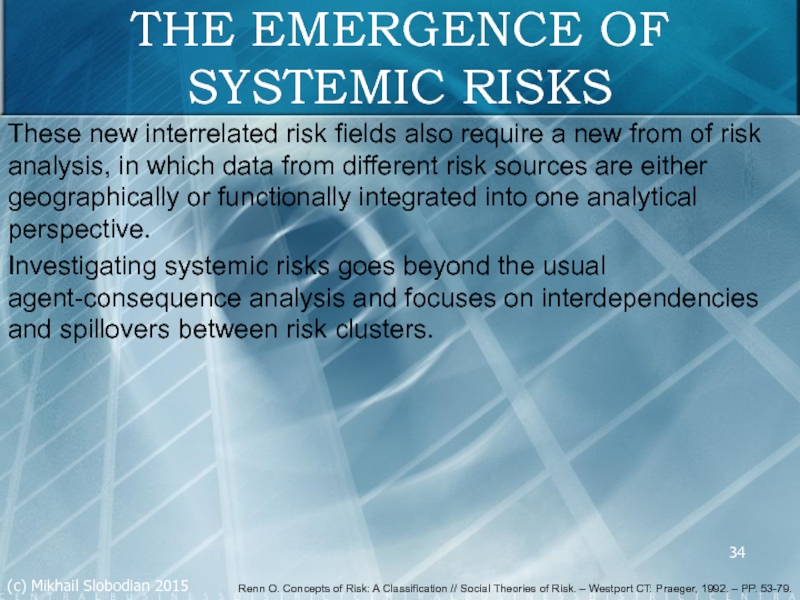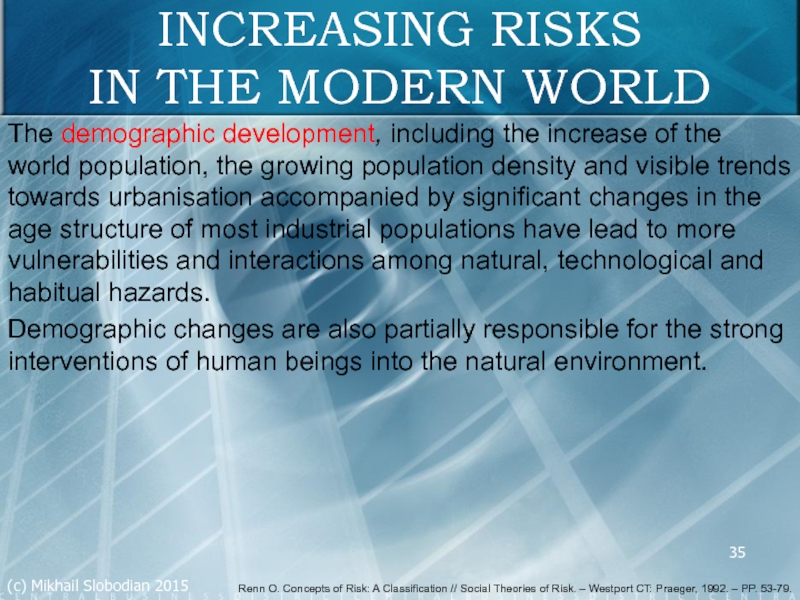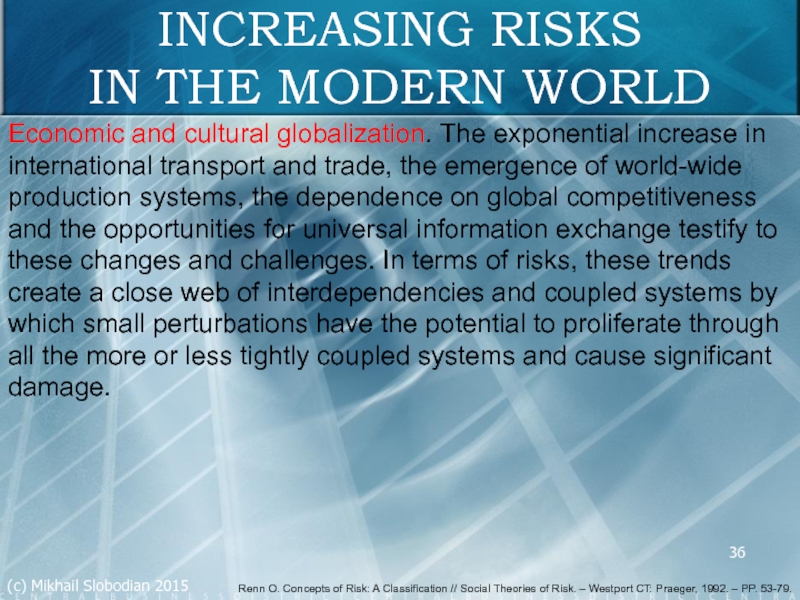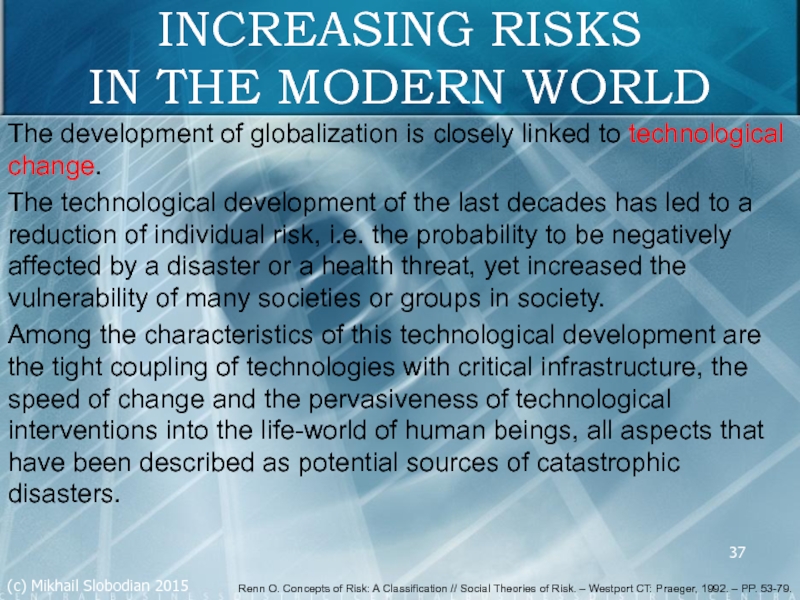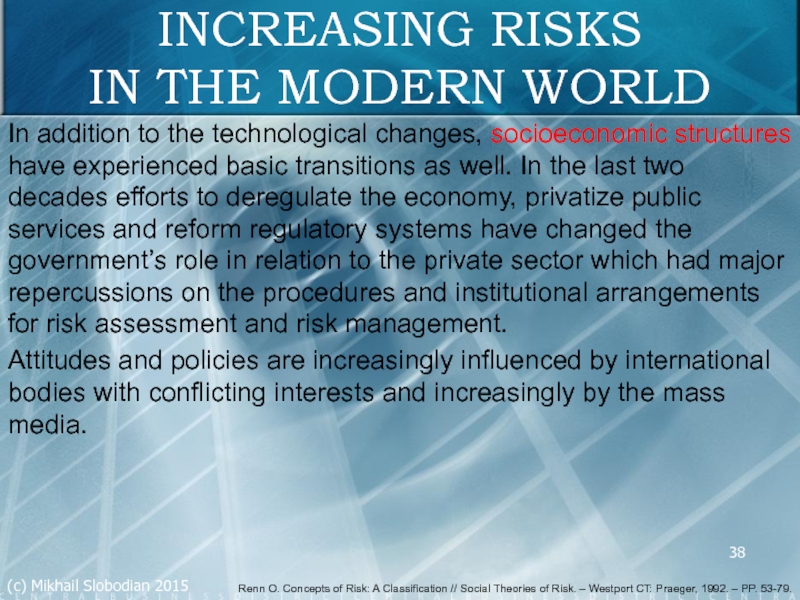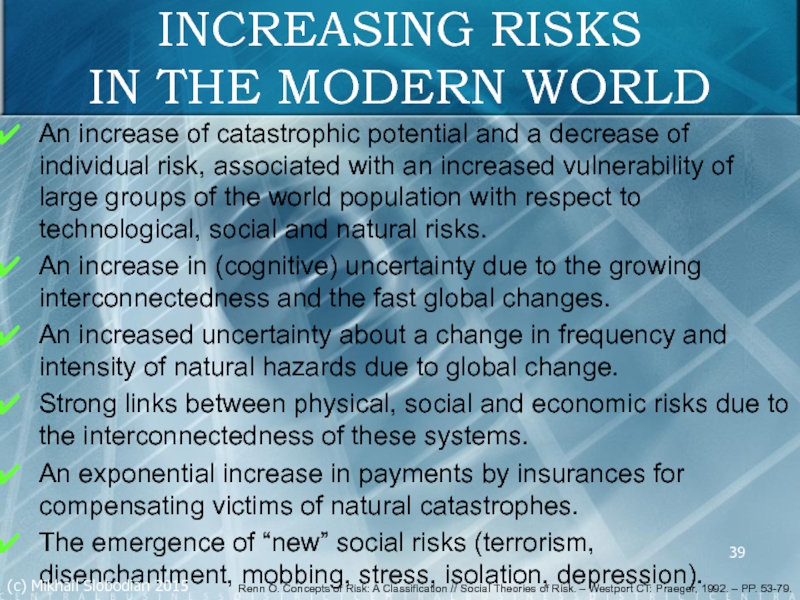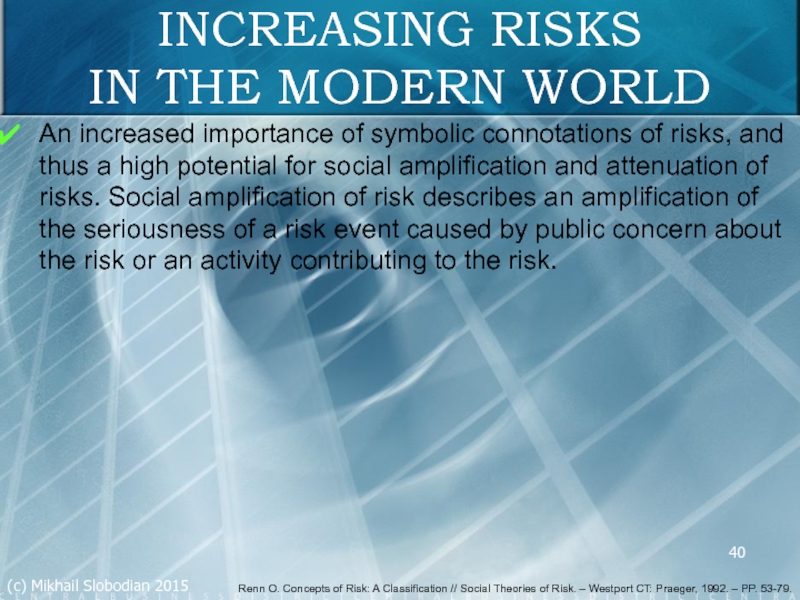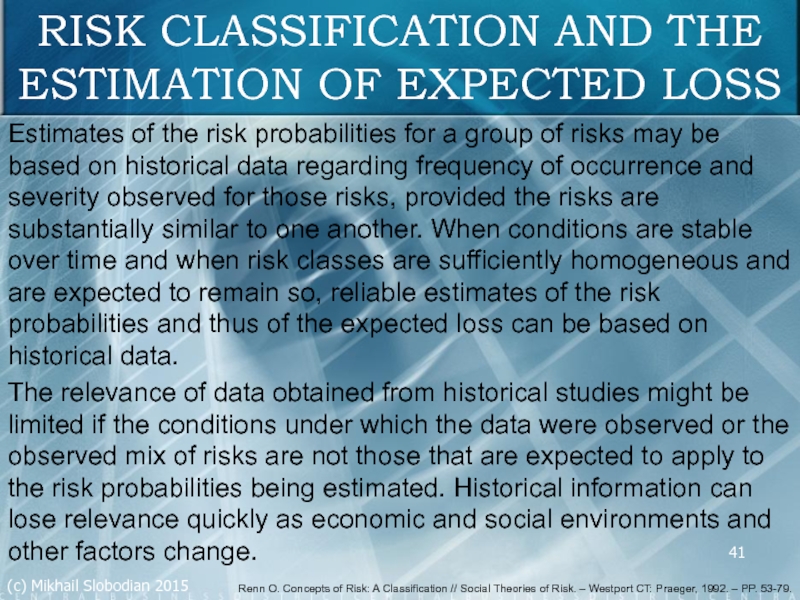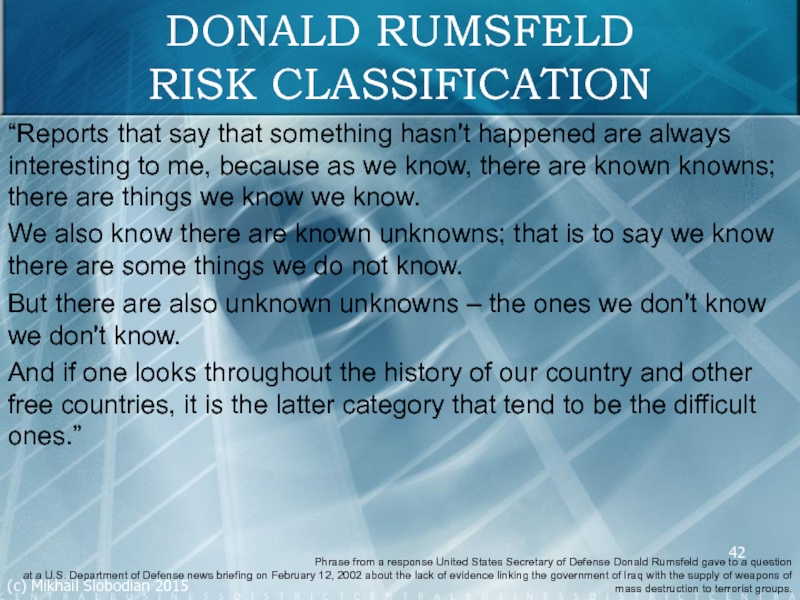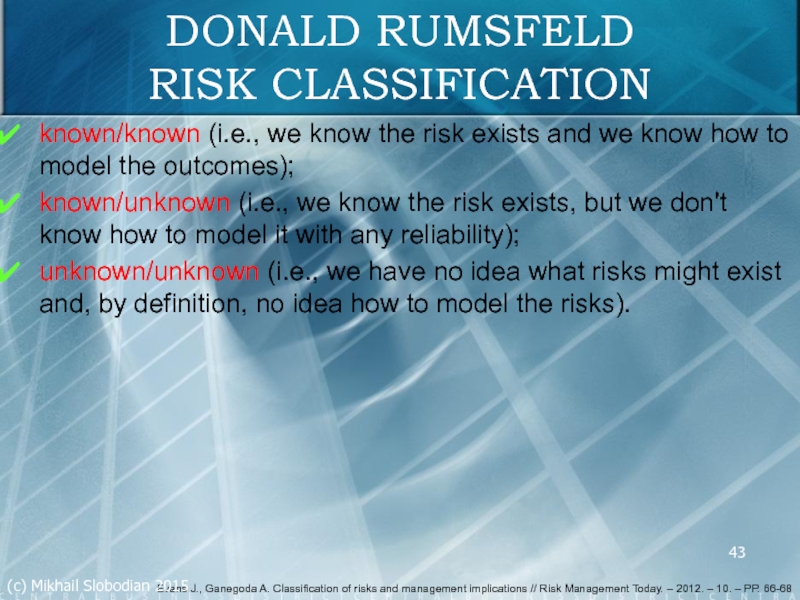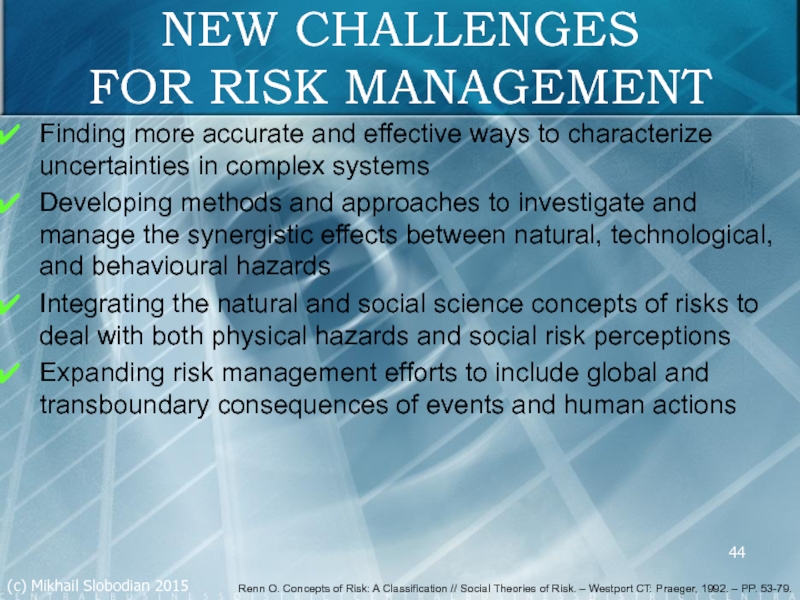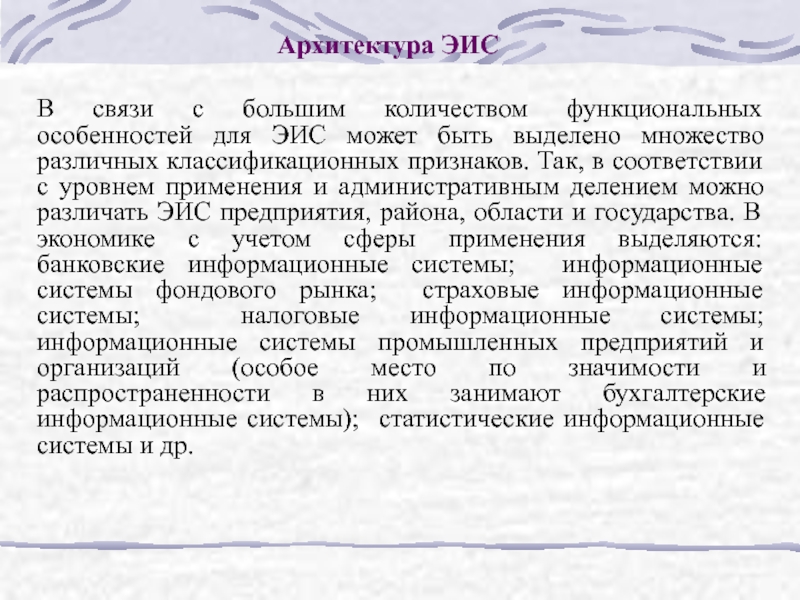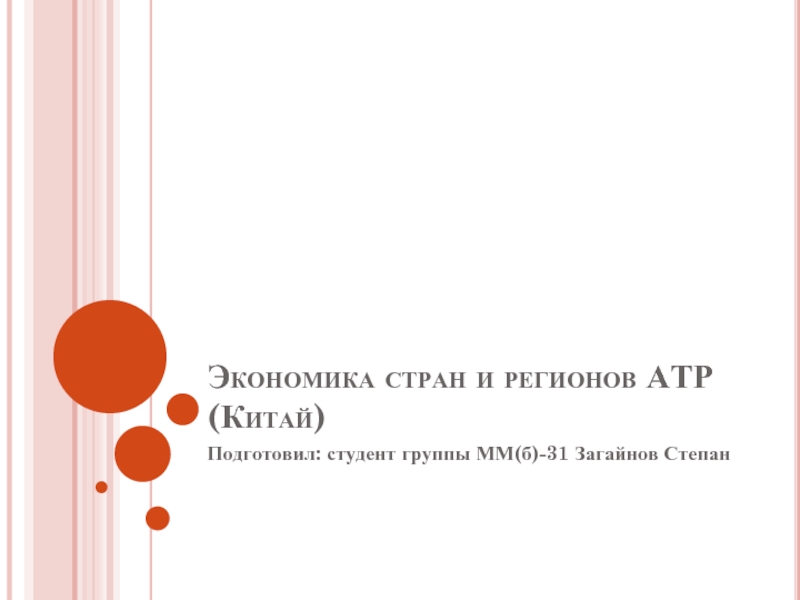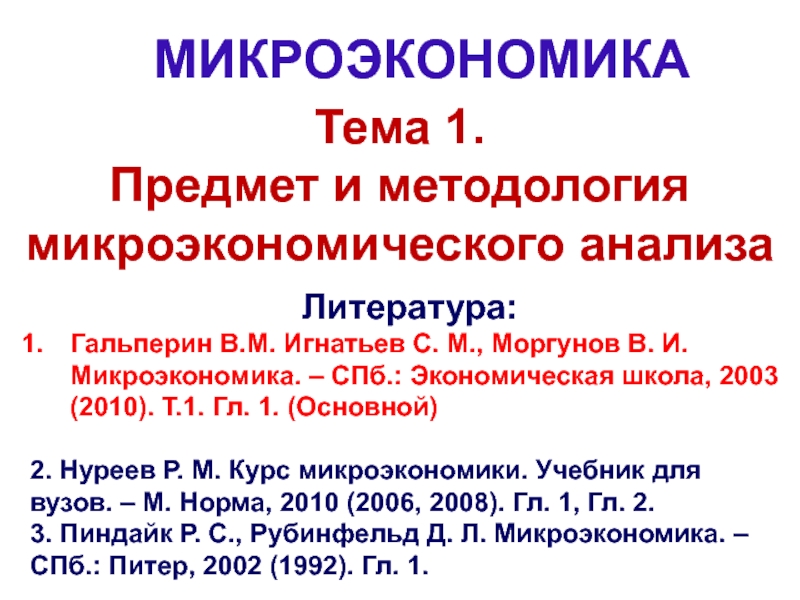- Главная
- Разное
- Дизайн
- Бизнес и предпринимательство
- Аналитика
- Образование
- Развлечения
- Красота и здоровье
- Финансы
- Государство
- Путешествия
- Спорт
- Недвижимость
- Армия
- Графика
- Культурология
- Еда и кулинария
- Лингвистика
- Английский язык
- Астрономия
- Алгебра
- Биология
- География
- Детские презентации
- Информатика
- История
- Литература
- Маркетинг
- Математика
- Медицина
- Менеджмент
- Музыка
- МХК
- Немецкий язык
- ОБЖ
- Обществознание
- Окружающий мир
- Педагогика
- Русский язык
- Технология
- Физика
- Философия
- Химия
- Шаблоны, картинки для презентаций
- Экология
- Экономика
- Юриспруденция
A short introduction to theory of risk презентация
Содержание
- 1. A short introduction to theory of risk
- 2. (c) Mikhail Slobodian 2015 RISK & UNCERTAINTY
- 3. DEFINITIONS OF RISK Risk
- 4. Risk is equal to
- 5. MASLOW'S HIERARCHY OF NEEDS commons.wikimedia.org RISK (c) Mikhail Slobodian 2015
- 6. THE CONCEPT OF RISK
- 7. RISKS AND RISK SUBJECTS
- 8. RISKS AND RISK SUBJECTS
- 9. PERIL AVOIDANCE AND RISK REDUCTION
- 10. TRANSFER OF RISK Risks
- 11. RISK CHARACTERISTICS Risk classification
- 12. RISK CHARACTERISTICS Age, for
- 13. RISK CHARACTERISTICS The “useful
- 14. RISK CHARACTERISTICS In cases
- 15. APPROACHES TO THE CONCEPTION AND ASSESSMENT OF
- 16. A SYSTEMATIC CLASSIFICATION OF RISK PERSPECTIVES
- 17. APPROACHES TO THE CONCEPTION AND ASSESSMENT OF
- 18. APPROACHES TO THE CONCEPTION AND ASSESSMENT OF
- 19. TECHNICAL RISK ANALYSES The
- 20. TECHNICAL RISK ANALYSES The
- 21. TECHNICAL RISK ANALYSES Probabilistic
- 22. TECHNICAL RISK ANALYSES A
- 23. TECHNICAL RISK ANALYSES The
- 24. TECHNICAL RISK ANALYSES the
- 25. TECHNICAL RISK ANALYSES From
- 26. TECHNICAL RISK ANALYSES Furthermore,
- 27. ECONOMIC PERSPECTIVES ON RISK
- 28. ECONOMIC PERSPECTIVES ON RISK
- 29. ECONOMIC PERSPECTIVES ON RISK
- 30. ECONOMIC PERSPECTIVES ON RISK
- 31. FUNCTIONS OF ECONOMIC APPROACH IN RISK POLICIES
- 32. PSYCHOLOGICAL PERSPECTIVES ON RISK
- 33. THE EMERGENCE OF SYSTEMIC RISKS
- 34. THE EMERGENCE OF SYSTEMIC RISKS
- 35. INCREASING RISKS IN THE MODERN WORLD
- 36. INCREASING RISKS IN THE MODERN WORLD
- 37. INCREASING RISKS IN THE MODERN WORLD
- 38. INCREASING RISKS IN THE MODERN WORLD
- 39. Renn O. Concepts of Risk: A Classification
- 40. INCREASING RISKS IN THE MODERN WORLD
- 41. RISK CLASSIFICATION AND THE ESTIMATION OF EXPECTED
- 42. DONALD RUMSFELD RISK CLASSIFICATION
- 43. DONALD RUMSFELD RISK CLASSIFICATION
- 44. NEW CHALLENGES FOR RISK MANAGEMENT
Слайд 2(c) Mikhail Slobodian 2015
RISK & UNCERTAINTY
http://3.bp.blogspot.com/
http://share.its.ac.id/
In economics literature,
a distinction often is
“risk” is used when probabilities of possible outcomes are known or at least estimable;
“uncertainty” is reserved for situations where such probabilities cannot be estimated.
Слайд 3DEFINITIONS OF RISK
Risk equals the expected loss (Willis, 2007)
Risk equals the
Risk is the probability of an adverse outcome (Graham and Weiner, 1995)
Risk is a measure of the probability and severity of adverse effects (Lowrance, 1976)
Risk is the combination of probability and extent of consequences (Ali, 2002)
Risk is equal to the triplet (Sj, pi, Cj), where Sj is the ith scenario, pj is the probability of that scenario, and Cj is the consequence of the ith scenario, i = 1, 2, ..N (Kaplan and Garrick, 1981; Kaplan, 1991)
(c) Mikhail Slobodian 2015
Слайд 4
Risk is equal to the two-dimensional combination of events/consequences and associated
Risk refers to uncertainty of outcome, of actions and events (Cabinet Office, 2002)
Risk is potential losses associated with a hazard or an extreme event to a given place within a given period of time, which can be defined in terms of the adverse consequences (damage/losses) and the probability of occurrence (Yan J. Disaster Risk Assessment: Understanding the Concept of Risk // http://www.gripweb.org/).
DEFINITIONS OF RISK
(c) Mikhail Slobodian 2015
Слайд 6THE CONCEPT OF RISK
Risk is always the risk of something (technical
Risk is perceived not solely by technical parameters and probabilistic numbers, but in psychological, social and cultural context.
Individual and social characteristics form risk perception and influence the way we react towards risks.
Risk perception is attenuated or amplified in a typical pattern described by the psychometric paradigma.
Schmidt M. Investigating risk perception: a short introduction
(c) Mikhail Slobodian 2015
Слайд 7RISKS AND RISK SUBJECTS
A peril is a cause of possible injury
Risks can be monetary (having outcomes that are expressed in monetary terms) or nonmonetary in nature. The non-monetary risks associated with a house fire include the risk of physical damage, as well as the risks of inconvenience and emotional upset, while the monetary risks include the risk of incurring expense to repair the structure or to provide temporary housing to the occupants. Since a fire can result in damage to any part of the house and to any of the contents of the house, the list of possible outcomes for the risk of physical damage is (infinitely) long.
Schmidt M. Investigating risk perception: a short introduction
(c) Mikhail Slobodian 2015
Слайд 8RISKS AND RISK SUBJECTS
Risks often are associated with a specific person
а life and health insurance risk, for instance, is associated with a specific human being;
а collision risk is associated with a specific automobile.
A risk subject is a person or thing, or a collection of persons or things, associated with a risk.
Schmidt M. Investigating risk perception: a short introduction
(c) Mikhail Slobodian 2015
Слайд 9PERIL AVOIDANCE AND
RISK REDUCTION
Some perils can be avoided. The chance of
The risks created by other perils can be minimized. The likelihood of being injured in an airplane accident can be reduced greatly by not flying. It cannot be eliminated totally, as on rare occasions people on the ground have become victims of airplane crashes. The incidence and severity of injury or loss associated with other perils can be reduced significantly by taking appropriate safety precautions. Periodic maintenance of the electrical systems of a building, for example, may reduce the incidence of fires in that building, and both smoke detectors and automatic sprinklers may reduce the severity of fire losses. Taking such precautions may be called “risk reduction.”
Schmidt M. Investigating risk perception: a short introduction
(c) Mikhail Slobodian 2015
Слайд 10TRANSFER OF RISK
Risks can result in adverse financial or personal consequences
If available resources, such as personal savings, are sufficient to easily offset these consequences, additional mitigating action may not be needed.
In situations in which this is not the case, ignoring the potential impact of such risks could be undesirable. Accordingly, various approaches have been devised to mitigate such impact.
Mitigation of the adverse consequences of an uncertain event often is provided by families, friends, privately funded charities, or government assistance, among others.
Mitigation also is provided by governmental or private insurance programs or prepaid service plans.
Schmidt M. Investigating risk perception: a short introduction
(c) Mikhail Slobodian 2015
Слайд 11RISK CHARACTERISTICS
Risk classification typically involves the identification of certain characteristics of
Observable qualities of the risk subjects that provide useful information about the risk probabilities associated with the risk are called risk characteristics.
Schmidt M. Investigating risk perception: a short introduction
(c) Mikhail Slobodian 2015
Слайд 12RISK CHARACTERISTICS
Age, for example, is a quality associated with a person
For example, the solidity of construction of a car and the health of a person might provide useful information about the risks involved in collision coverage. Similarly, the health of a person might provide useful information about the risks involved in life insurance coverage. But, under most circumstances, the color of the car’s upholstery is not an indicator of the likelihood or severity of a collision and the color of a person’s eyes is not an indicator of longevity. Observable qualities of the risk subjects that do provide useful information about the risk probabilities associated with the risk are called risk characteristics.
Schmidt M. Investigating risk perception: a short introduction
(c) Mikhail Slobodian 2015
Слайд 13RISK CHARACTERISTICS
The “useful information” provided by risk characteristics often will emerge
The ways risk characteristics are used in a risk classification system vary. A value often is determined for each risk characteristic and the set of these values determines the risk class to which the risk is assigned.
Schmidt M. Investigating risk perception: a short introduction
(c) Mikhail Slobodian 2015
Слайд 14RISK CHARACTERISTICS
In cases in which a specific quality of the risk
The existence of a persistent correlation often prompts a search for an explanation that takes the form “A causes B.” A cause and effect explanation sometimes is readily apparent. This is true, for example, for the correlation of a prior heart attack with shortened longevity.
Sometimes, however, a statistical correlation may be well-established, but a cause and effect explanation may not be evident. In such cases, introduction of additional risk characteristics might facilitate a more accurate assessment of the relevant risk probabilities.
Schmidt M. Investigating risk perception: a short introduction
(c) Mikhail Slobodian 2015
Слайд 15APPROACHES TO THE CONCEPTION AND ASSESSMENT OF RISK
the actuarial approach (using
the toxicological and epidemiological approach (including ecotoxicology);
the engineering approach (including probabilistic risk assessment);
the economic approach (including risk-benefit comparisons);
the psychological approach (including psychometric analysis);
social theories of risk;
cultural theory of risk (using grid-group analysis).
Renn O. Concepts of Risk: A Classification // Social Theories of Risk. – Westport CT: Praeger, 1992. – PP. 53-79.
(c) Mikhail Slobodian 2015
Слайд 16A SYSTEMATIC CLASSIFICATION OF RISK PERSPECTIVES
Renn O. Concepts of Risk: A
Social Theories of Risk. – Westport CT: Praeger, 1992. – PP. 53-79.
(c) Mikhail Slobodian 2015
Слайд 17APPROACHES TO THE CONCEPTION AND ASSESSMENT OF RISK
All risk concepts have
the distinction between reality and possibility.
If this distinction is accepted, the term “risk” denotes the possibility that an undesirable state of reality (adverse effects) may occur as a result of natural events or human activities.
This definition implies that humans can and will make causal connections between actions (or events) and their effects, and that undesirable effects can be avoided or mitigated if the causal events or actions are avoided or modified. Risk is therefore both a descriptive and a normative concept. It includes the analysis of cause-effect relationships, which may be scientific, anecdotal, religious, or magical; but it also carries the implicit message to reduce undesirable effects through appropriate modification of the causes or, though less desirable, mitigation of the consequences.
Renn O. Concepts of Risk: A Classification // Social Theories of Risk. – Westport CT: Praeger, 1992. – PP. 53-79.
(c) Mikhail Slobodian 2015
Слайд 18APPROACHES TO THE CONCEPTION AND ASSESSMENT OF RISK
The definition of risk
undesirable outcomes;
possibility of occurrence;
state of reality.
All risk perspectives provide different conceptualizations of these three elements. They are paraphrased in the following three questions:
How can we specify or measure uncertainties?
What are undesirable outcomes?
What is the underlying concept of reality?
Renn O. Concepts of Risk: A Classification // Social Theories of Risk. – Westport CT: Praeger, 1992. – PP. 53-79.
(c) Mikhail Slobodian 2015
Слайд 19TECHNICAL RISK ANALYSES
The actuarial approach provides a straight-forward answer to these
The undesirable events are confined to physical harm to humans or ecosystems, which can be objectively observed or measured by appropriate scientific methods. An application of this approach may be the prediction of fatalities in car accidents for the coming year. The expected value can be extrapolated from the statistical data about fatal accidents in previous years.
This perspective of risk relies on two conditions:
enough statistical data must be available to make meaningful predictions;
the causal agents that are responsible for the negative effects must remain stable over the predicted time period.
Renn O. Concepts of Risk: A Classification // Social Theories of Risk. – Westport CT: Praeger, 1992. – PP. 53-79.
(c) Mikhail Slobodian 2015
Слайд 20TECHNICAL RISK ANALYSES
The assessment of health and environmental risks is similar
In risk assessments, causal relationships have to be explored and modeled explicitly. Based on toxicological (animal experiments) or epidemiological studies (comparison of a population exposed to a risk agent with a population not exposed to the risk agent), researchers try to identify and quantify the relationship between a potential risk agent (such as dioxin or ionizing radiation) and physical harm observed in humans or other living organisms.
Modeling is used to isolate a causal agent from among several intervening variables. These risk assessments can serve as early warning signals to inform society that a specific substance may cause harm to humans or the environment.
Renn O. Concepts of Risk: A Classification // Social Theories of Risk. – Westport CT: Praeger, 1992. – PP. 53-79.
(c) Mikhail Slobodian 2015
Слайд 21TECHNICAL RISK ANALYSES
Probabilistic risk assessments attempt to predict the probability of
Using fault-tree or event-tree analyses, the failure probabilities for each component of the system are systematically assessed and then linked to the system structure. All probabilities of such a logical tree are then synthesized in order to model the overall failure rate of the system.
Renn O. Concepts of Risk: A Classification // Social Theories of Risk. – Westport CT: Praeger, 1992. – PP. 53-79.
(c) Mikhail Slobodian 2015
Слайд 22TECHNICAL RISK ANALYSES
A probabilistic risk assessment provides the same product as
Probabilistic risk assessments have been specifically valuable in detecting deficiencies in complex technical systems and in improving the safety performance of the technical system under consideration.
Renn O. Concepts of Risk: A Classification // Social Theories of Risk. – Westport CT: Praeger, 1992. – PP. 53-79.
(c) Mikhail Slobodian 2015
Слайд 23TECHNICAL RISK ANALYSES
The technical analyses of risk have drawn much criticism
what people perceive as an undesirable effect depends on their values and preferences;
the interactions between human activities and consequences are more complex and unique than the average probabilities used in technical risk analyses are able to capture;
the institutional structure of managing and controlling risks is prone to organizational failures and deficits which may increase the actual risk (the interaction between organizational malfunctions and risk is usually excluded from technical risk analyses);
Renn O. Concepts of Risk: A Classification // Social Theories of Risk. – Westport CT: Praeger, 1992. – PP. 53-79.
(c) Mikhail Slobodian 2015
Слайд 24TECHNICAL RISK ANALYSES
the numerical combination of magnitude and probabilities assumes equal
Renn O. Concepts of Risk: A Classification // Social Theories of Risk. – Westport CT: Praeger, 1992. – PP. 53-79.
(c) Mikhail Slobodian 2015
Слайд 25TECHNICAL RISK ANALYSES
From the normative perspective, the practice of risk minimization
Risk reduction or mitigation is based on the assumption that risk should be reduced in proportion to the expected or modeled harm to humans or ecosystems. This assumption is highly contested: social actions to cope with risk are not confined to the single goal of risk minimization but include other objectives such as equity, fairness, flexibility, or resilience. The inclusion of these complementary objectives requires participation by interest groups and the affected public.
Renn O. Concepts of Risk: A Classification // Social Theories of Risk. – Westport CT: Praeger, 1992. – PP. 53-79.
(c) Mikhail Slobodian 2015
Слайд 26TECHNICAL RISK ANALYSES
Furthermore, technical risk analyses can provide only aggregate data
A person who is exposed to a larger risk than the average person may legitimately object to a risk policy based on aggregate calculations. The extent to which a person is exposed to a specific risk also rests on lifestyle factors and anecdotal knowledge, both of which are mostly unknown to scientists performing risk analyses.
The dominance of science in risk policy making provides too much power to an elite that is neither qualified nor politically legitimated to impose risks or risk management policies on a population.
Renn O. Concepts of Risk: A Classification // Social Theories of Risk. – Westport CT: Praeger, 1992. – PP. 53-79.
(c) Mikhail Slobodian 2015
Слайд 27ECONOMIC PERSPECTIVES
ON RISK
All risk concepts of the social sciences have in
The base unit of utilities describes the degree of satisfaction or dissatisfaction associated with a possible action or transaction. Whether physical harm is evaluated as pleasure or disaster remains irrelevant in the technical understanding of risk.
Not so in economics: the relevant criterion is the subjective satisfaction with the potential consequences rather than a predefined list of undesirable effects.
Renn O. Concepts of Risk: A Classification // Social Theories of Risk. – Westport CT: Praeger, 1992. – PP. 53-79.
(c) Mikhail Slobodian 2015
Слайд 28ECONOMIC PERSPECTIVES
ON RISK
The shift from expected harm to expected utility serves
subjective (dis)satisfaction can be measured for all consequences, including psychological or social effects that are deemed undesirable;
the common denominator “personal satisfaction” allows a direct comparison between risks and benefits across different options.
Using utilities instead of physical harm provides a common denominator that enables each individual to compare options with different benefit profiles according to overall satisfaction.
Utility is universal and one-dimensional.
Renn O. Concepts of Risk: A Classification // Social Theories of Risk. – Westport CT: Praeger, 1992. – PP. 53-79.
(c) Mikhail Slobodian 2015
Слайд 29ECONOMIC PERSPECTIVES
ON RISK
The economic risk concept constitutes a consistent and coherent
Most decisions on risks are collective decisions (public or meritocratic goods), which require the aggregation of individual utilities. How to measure the welfare of society, however, remains a major problem, since the subjective nature of utility does not provide a logically valid method to aggregate individual utilities into a single societal welfare function. Averaging over expressed preferences is a common but unsatisfactory method for determining the utility of collective goods.
Renn O. Concepts of Risk: A Classification // Social Theories of Risk. – Westport CT: Praeger, 1992. – PP. 53-79.
(c) Mikhail Slobodian 2015
Слайд 30ECONOMIC PERSPECTIVES
ON RISK
The two basic foundations of economics are the rational
At the same time, people show compassion for others and may seek to increase the utility of other people even at their own expense. This behavior is contrary to the naive version of the rational actor paradigm, which postulates that people with full information will act in accordance with their own interests. Economic theory is, however, compatible with a modified and more realistic version of the rational actor paradigm, which assumes that people have subjective motives for performing an action and that they try to assess consequences of their action in the light of these motives.
Renn O. Concepts of Risk: A Classification // Social Theories of Risk. – Westport CT: Praeger, 1992. – PP. 53-79.
(c) Mikhail Slobodian 2015
Слайд 31FUNCTIONS OF ECONOMIC APPROACH IN RISK POLICIES
It provides techniques and instruments
It enhances technical risk analyses by providing a broader definition of undesirable events, which include nonphysical aspects of risk.
Under the assumption that market prices (or shadow prices) represent social utilities, it provides techniques to measure distinctly different types of benefits and risks with the same unit.
It includes a model for rational decision making, provided that the decision makers can reach agreement about the utilities associated with each option.
(c) Mikhail Slobodian 2015
Renn O. Concepts of Risk: A Classification // Social Theories of Risk. – Westport CT: Praeger, 1992. – PP. 53-79.
Слайд 32PSYCHOLOGICAL PERSPECTIVES ON RISK
The psychological perspective on risk expands the realm
it focuses on personal preferences for probabilities and attempts to explain why individuals do not base their risk judgments on expected values;
more specific studies on the perception of probabilities in decision making identified several biases in people’s ability to draw inferences from probabilistic information (these biases refer to the intuitive processing of uncertainty);
the importance of contextual variables for shaping individual risk estimations and evaluations.
(c) Mikhail Slobodian 2015
Renn O. Concepts of Risk: A Classification // Social Theories of Risk. – Westport CT: Praeger, 1992. – PP. 53-79.
Слайд 33THE EMERGENCE OF SYSTEMIC RISKS
The modern concept of emerging systemic risks
(c) Mikhail Slobodian 2015
Renn O. Concepts of Risk: A Classification // Social Theories of Risk. – Westport CT: Praeger, 1992. – PP. 53-79.
Слайд 34THE EMERGENCE OF SYSTEMIC RISKS
These new interrelated risk fields also require
Investigating systemic risks goes beyond the usual agent-consequence analysis and focuses on interdependencies and spillovers between risk clusters.
(c) Mikhail Slobodian 2015
Renn O. Concepts of Risk: A Classification // Social Theories of Risk. – Westport CT: Praeger, 1992. – PP. 53-79.
Слайд 35INCREASING RISKS
IN THE MODERN WORLD
The demographic development, including the increase of
Demographic changes are also partially responsible for the strong interventions of human beings into the natural environment.
(c) Mikhail Slobodian 2015
Renn O. Concepts of Risk: A Classification // Social Theories of Risk. – Westport CT: Praeger, 1992. – PP. 53-79.
Слайд 36INCREASING RISKS
IN THE MODERN WORLD
Economic and cultural globalization. The exponential increase
(c) Mikhail Slobodian 2015
Renn O. Concepts of Risk: A Classification // Social Theories of Risk. – Westport CT: Praeger, 1992. – PP. 53-79.
Слайд 37INCREASING RISKS
IN THE MODERN WORLD
The development of globalization is closely linked
The technological development of the last decades has led to a reduction of individual risk, i.e. the probability to be negatively affected by a disaster or a health threat, yet increased the vulnerability of many societies or groups in society.
Among the characteristics of this technological development are the tight coupling of technologies with critical infrastructure, the speed of change and the pervasiveness of technological interventions into the life-world of human beings, all aspects that have been described as potential sources of catastrophic disasters.
(c) Mikhail Slobodian 2015
Renn O. Concepts of Risk: A Classification // Social Theories of Risk. – Westport CT: Praeger, 1992. – PP. 53-79.
Слайд 38INCREASING RISKS
IN THE MODERN WORLD
In addition to the technological changes, socioeconomic
Attitudes and policies are increasingly influenced by international bodies with conflicting interests and increasingly by the mass media.
(c) Mikhail Slobodian 2015
Renn O. Concepts of Risk: A Classification // Social Theories of Risk. – Westport CT: Praeger, 1992. – PP. 53-79.
Слайд 39Renn O. Concepts of Risk: A Classification // Social Theories of
INCREASING RISKS
IN THE MODERN WORLD
An increase of catastrophic potential and a decrease of individual risk, associated with an increased vulnerability of large groups of the world population with respect to technological, social and natural risks.
An increase in (cognitive) uncertainty due to the growing interconnectedness and the fast global changes.
An increased uncertainty about a change in frequency and intensity of natural hazards due to global change.
Strong links between physical, social and economic risks due to the interconnectedness of these systems.
An exponential increase in payments by insurances for compensating victims of natural catastrophes.
The emergence of “new” social risks (terrorism, disenchantment, mobbing, stress, isolation, depression).
(c) Mikhail Slobodian 2015
Слайд 40INCREASING RISKS
IN THE MODERN WORLD
An increased importance of symbolic connotations of
(c) Mikhail Slobodian 2015
Renn O. Concepts of Risk: A Classification // Social Theories of Risk. – Westport CT: Praeger, 1992. – PP. 53-79.
Слайд 41RISK CLASSIFICATION AND THE ESTIMATION OF EXPECTED LOSS
Estimates of the risk
The relevance of data obtained from historical studies might be limited if the conditions under which the data were observed or the observed mix of risks are not those that are expected to apply to the risk probabilities being estimated. Historical information can lose relevance quickly as economic and social environments and other factors change.
(c) Mikhail Slobodian 2015
Renn O. Concepts of Risk: A Classification // Social Theories of Risk. – Westport CT: Praeger, 1992. – PP. 53-79.
Слайд 42DONALD RUMSFELD
RISK CLASSIFICATION
“Reports that say that something hasn't happened are
We also know there are known unknowns; that is to say we know there are some things we do not know.
But there are also unknown unknowns – the ones we don't know we don't know.
And if one looks throughout the history of our country and other free countries, it is the latter category that tend to be the difficult ones.”
Phrase from a response United States Secretary of Defense Donald Rumsfeld gave to a question
at a U.S. Department of Defense news briefing on February 12, 2002 about the lack of evidence linking the government of Iraq with the supply of weapons of mass destruction to terrorist groups.
(c) Mikhail Slobodian 2015
Слайд 43DONALD RUMSFELD
RISK CLASSIFICATION
known/known (i.e., we know the risk exists and
known/unknown (i.e., we know the risk exists, but we don't know how to model it with any reliability);
unknown/unknown (i.e., we have no idea what risks might exist and, by definition, no idea how to model the risks).
Evans J., Ganegoda A. Classification of risks and management implications // Risk Management Today. – 2012. – 10. – PP. 66-68
(c) Mikhail Slobodian 2015
Слайд 44NEW CHALLENGES
FOR RISK MANAGEMENT
Finding more accurate and effective ways to characterize
Developing methods and approaches to investigate and manage the synergistic effects between natural, technological, and behavioural hazards
Integrating the natural and social science concepts of risks to deal with both physical hazards and social risk perceptions
Expanding risk management efforts to include global and transboundary consequences of events and human actions
(c) Mikhail Slobodian 2015
Renn O. Concepts of Risk: A Classification // Social Theories of Risk. – Westport CT: Praeger, 1992. – PP. 53-79.
